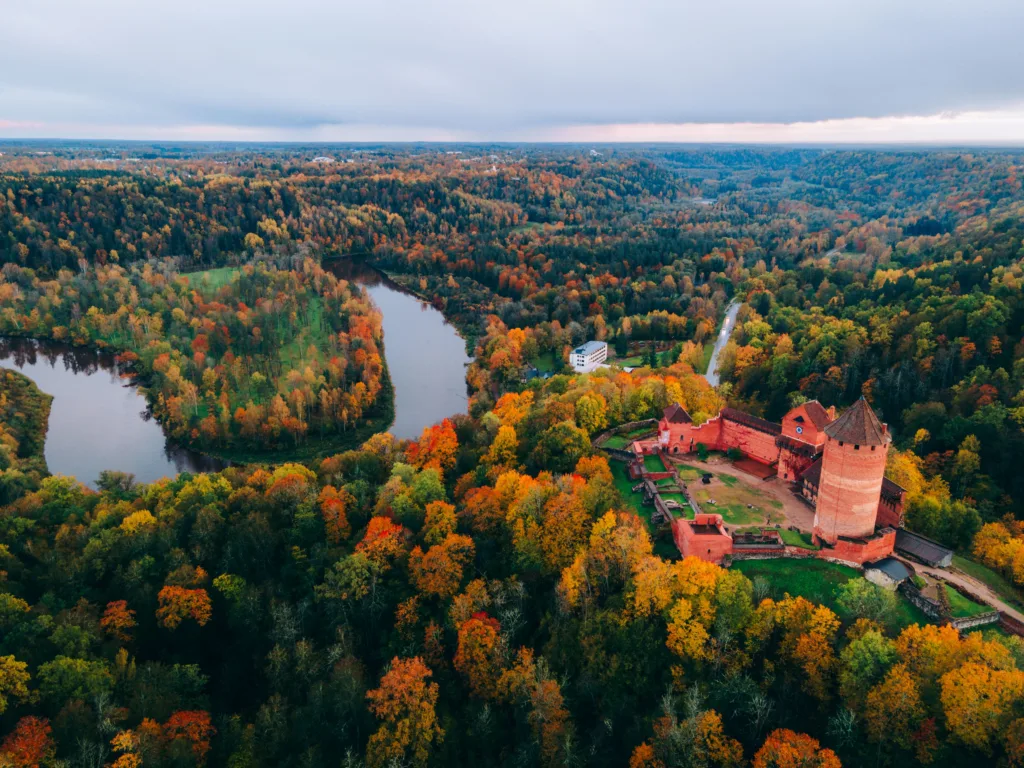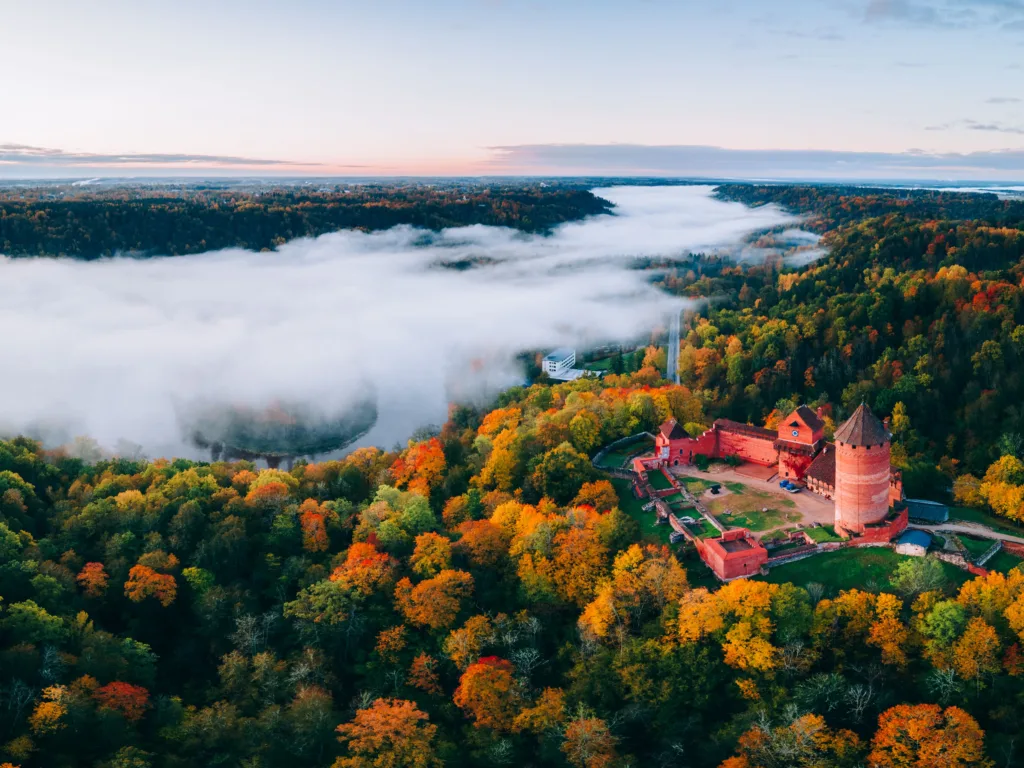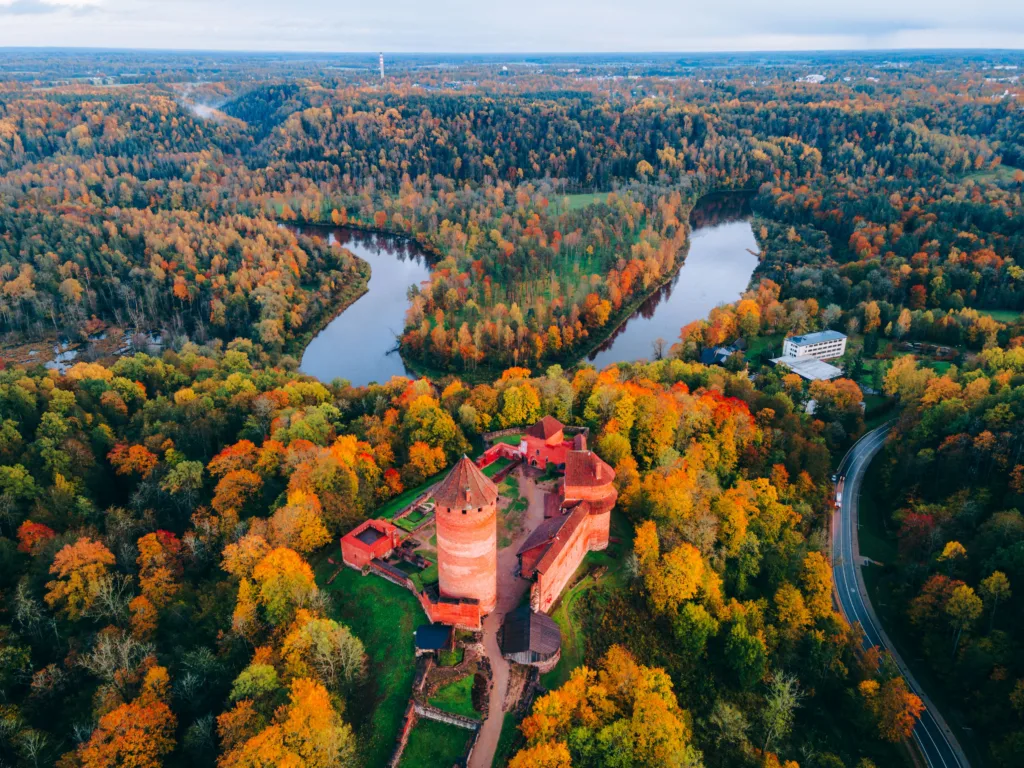
Turaida Castle, nestled in the scenic Gauja National Park near Sigulda, Latvia, stands as a testament to the medieval history of the region. Built in the early 13th century during the Livonian Crusade, the castle reflects the architectural style of the other Baltic Crusades, with mostly red bricks making up the building.
Over the centuries, Turaida Castle witnessed various historical events and fell into disrepair. However, in the 20th century, extensive restoration efforts breathed new life into its ancient walls, allowing visitors to explore the well-preserved site and part of the original ruins.
The castle, with its main tower and surrounding defensive walls, offers panoramic views of the Gauja River valley. The panoramic views from the castle walls contribute to its allure as a tourist destination.
The restoration aimed to recreate the castle’s appearance during the Livonian Confederation period, providing a glimpse into medieval life.
The complex houses a museum that delves into the history of the region, the Livonian Crusade, and medieval life. Visitors can explore archaeological findings and immerse themselves in the rich cultural heritage of Turaida.
It’s one of Latvia’s main historical sites and many schools come here to make their children learn about one of the highest expressions of Medieval history in Latvia.
Its restored grandeur invites visitors to step back in time and appreciate the enduring legacy of this medieval stronghold.
Surrounded by the natural beauty of Gauja National Park, Turaida Castle becomes part of a larger experience in Sigulda. The town itself is a hub for outdoor enthusiasts, offering hiking trails, caves, and the picturesque Gauja River valley.
Table of Contents
Turaida Museum Reserve

The Turaida Castle complex is part of the Turaida Museum Reserve, which encompasses not only the castle but also the surrounding area with historical buildings serving exhibitions and a large outdoor space covering over 43 hectares.
The museum offers insights into the history of the region, the Livonian Confederation, and the archaeological findings at Turaida dating back to when it was inhabited by the Livs.
Within the Reserve, visitors can explore exhibitions showcasing artifacts from different periods of Turaida’s history. These exhibits provide insights into the daily life of the castle’s inhabitants, the military conflicts it witnessed, and the cultural and economic aspects of medieval Livonia.
The Complex is one of the most iconic and most visited historical sights in Latvia. The variety of activities to do in and around the Reserve is second to none in the country, and people who want to get out of Riga for a day trip love it as an easy-to-reach destination.
How to Get to Turaida Castle
With over a dozen trains a day going from Riga’s Central Station to Sigulda, the closest town to the Complex, getting to Turaida Castle is a great day trip from Riga.
The average train ride lasts 1h10 minutes and the cost is 1,89 euros. You can check the schedules on the official train website of Latvia.
Buses from Sigulda to Turaida leave frequently, about twice per hour, from the square in front of the train station.
However, I can strongly recommend renting a car and going on a road trip through Latvia, and possibly pairing it with the other Baltic states. The experience these three small countries can make you live is unique all year round.
With a car you can add Gauja National Park to your visit to Turaida Castle; the national park that develops along the Gauja River Valley, with some of the most important Medieval towns of Latvia.
History of Turaida Castle

The construction of Turaida Castle dates back to the early 13th century, during a tumultuous time in the Baltic region known as the Livonian Crusade. The Livonian Crusade was part of the broader Northern Crusades, a series of campaigns by European Christian forces to convert and subjugate the indigenous pagan tribes in the Baltic territories. In the case of Livonia (modern-day Latvia and Estonia), the Germanic Teutonic Knights and the Archbishopric of Riga played central roles in this military and religious endeavor.
Turaida Castle was established under the auspices of Albert, the Archbishop of Riga, in 1214.
Just like the Castle of the Medieval town of Cesis, Turaida Castle was also built by the Livonian Brothers of the Sword, the main Catholic Military order that took action in the area.
The castle served a strategic purpose in the conversion of the local Livonian tribes to Christianity and in securing the territory against potential invasions. The initial structure was likely a wooden fortress, and over time, it evolved into a more formidable stone castle.
Golden Age
During the 14th century, the construction of the Castle was greatly improved, with several companion defensive structures shaping up in the complex.
The golden age of Turaida Castle is often associated with the Livonian Confederation period, particularly in the late 15th century. During this time, the Livonian Confederation was formed, bringing together various territories under a loose political union. Turaida, along with other castles in the region, played a major role in the defense of Livonia against external threats.
Economically, this period saw the development of trade routes and economic prosperity in the Baltic region. The Hanseatic League, a powerful trading network, had a significant influence, contributing to the growth of towns and fortifications.
The rise of Turaida Castle during this era can be attributed to its strategic location along trade routes and its role as a defensive stronghold. The castle likely benefited from increased economic activity in the region, fostering a period of relative stability and growth.
Despite this growth, the property went hand in hand with most of the surroundings, going through several conflicts in this generally unstable period in the Baltics. The ruler of Turaida changed many times between the Livonian Order and the Archbishop of Riga.
Context in Latvia
Latvia, situated at the crossroads of Eastern and Western Europe, has a complex history marked by influences from various cultures.
In the medieval period, the territory that is now Latvia was inhabited by Baltic tribes with their unique languages and traditions. The Livonian Crusade and subsequent developments led to the integration of these tribes into the broader European cultural and religious sphere.
The establishment and growth of castles like Turaida were emblematic of this historical transformation. They not only served military and strategic purposes but also became centers of administration, trade, and culture.
The rise of Turaida Castle reflects the geopolitical and cultural dynamics of medieval Latvia, showcasing the convergence of indigenous Baltic, Germanic, and other European influences.
Livonian War and Turaida Castle’s Fall
The fall of Turaida Castle is part of the broader historical context of the Livonian War (1558–1583). This conflict had significant repercussions for the entire Livonian Confederation, including Latvia and its castles.
The Livonian War was a protracted and complex conflict involving multiple parties, including the Russian Tsardom, the Kingdom of Poland, the Grand Duchy of Lithuania, and the Teutonic Order. The Livonian Confederation, which included territories that are now part of Latvia, found itself caught in the crossfire of these power struggles.
In the early stages of the war, the Livonian Confederation was weakened by internal divisions and external pressures. Turaida Castle, like many other fortifications in the region, became a target for various military campaigns. The castle changed hands several times during the course of the war.
These events sent Turaida and many other strongholds in Northern Latvia into a decline, rapidly losing their strategic importance.
The Castle would go on to be inhabited up until a devastating fire in 1776, but ever since the Livonian war it was never repaired and it never regained its power.
Consequences of the Livonian War
The Livonian War had devastating consequences for the Livonian Confederation. The protracted conflict resulted in widespread destruction, economic decline, and depopulation. Turaida Castle, like many other fortifications in the region, suffered significant damage during the war.
The Treaty of Jam Zapolski in 1582 marked the end of the Livonian War. As a result, the territories of Livonia were divided among the victorious powers, with the southern part, including Turaida, coming under Polish-Lithuanian control. The castle, however, was left in ruins and was not restored to its former glory.
Legacy and Restoration
After the Livonian War, Turaida Castle did not regain its former prominence. It remained in a state of disrepair for centuries. The castle’s ruins became a poignant reminder of the historical struggles that unfolded in the region.
Only in the 20th century were restoration efforts initiated to preserve and showcase the historical and cultural significance of Turaida Castle. The restoration work aimed to recreate the castle’s appearance during the Livonian Confederation period, allowing visitors to explore its medieval heritage.
Who Inhabited Turaida Castle?
During the rise and golden age of Turaida Castle, its inhabitants were typically representatives of the Livonian Order, a branch of the Teutonic Order, and later, during the Livonian Confederation period, it may have been occupied by various military and administrative personnel.
Teutonic Order/Livonian Order
In the early stages of Turaida Castle’s history, particularly during its construction in the early 13th century, it was inhabited by members of the Teutonic Order and later the Livonian Order. The Teutonic Order was a medieval German military order originally formed for the purpose of providing medical care to pilgrims and maintaining a hospital in Jerusalem. However, it eventually became a military order engaged in the Baltic Crusades.
The Livonian Order was a branch of the Teutonic Order established specifically for the conquest and Christianization of the territories in the Baltic region, including what is now Latvia. Turaida Castle, as part of the Livonian Order’s defensive network, would have housed knights, clergy, and administrative staff associated with the order.
Nobility and Administrators
During the golden age of Turaida Castle in the late medieval period, as the Livonian Confederation formed, the castle was inhabited by members of the local nobility and administrative officials. The Livonian Confederation, a loose political union of territories in Livonia, brought together various noble families and ruling elites.
The castle served as both a military stronghold and a residence for local nobles and their retinues. The noble inhabitants would oversee the administration of the surrounding lands, collect taxes, and play a role in the governance of the region.
Military Garrison
Turaida Castle, strategically located along trade routes and serving a defensive purpose, housed a military garrison during its golden age. Soldiers, archers, and other military personnel were stationed at the castle to defend against potential invasions and maintain order in the surrounding region.
Surrounding Settlement
While Turaida Castle itself primarily served as a defensive fortress and residence for military and administrative personnel, there was a surrounding settlement or village that supported the castle’s activities. This settlement housed civilians, including craftsmen, farmers, and other individuals who provided goods and services to meet the needs of the castle’s inhabitants.
The village near Turaida Castle had craftsmen and tradespeople such as blacksmiths, carpenters, potters, and weavers. These individuals produced essential items for daily life, as well as goods needed for the castle’s maintenance and functioning.
Turaida also needed farmers to provide food, which is why the surrounding area was cultivated for agriculture to produce food for the castle’s inhabitants. Villagers were engaged in farming activities, cultivating crops, and raising livestock.
Given Turaida Castle’s strategic location, it was a focal point for trade. Traders and merchants from the surrounding village engaged in commerce, providing goods and services to the castle while facilitating the exchange of products with other nearby settlements.
The relationship between the castle and the surrounding village was been symbiotic, meaning that the castle offered protection to the villagers, and, in return, the villagers provided the castle with the necessary resources for sustenance and operation.
While the castle itself housed the military and administrative elite, the village formed a crucial part of the broader community that supported and sustained the castle’s activities. The combination of the castle and its surrounding settlement created a medieval complex where various social and economic functions were interconnected.
Rose of Turaida Legend
The tragic love story of the Rose of Turaida is the most famous legend associated with the castle. The story revolves around a young woman named Maija who lived in the castle during the 17th century. The tale involves love, betrayal, and a heartbreaking conclusion.
The grave of Maija and a memorial stone with a rose motif can be found near the castle, attracting visitors interested in the romantic folklore.
The story goes like this:
Maija Greif was a beautiful and virtuous young woman who lived in Turaida Castle. She worked in the household of the castle’s commandant, and she was known for her kind and gentle nature.
Maija fell in love with a Swedish soldier named Victor, who was stationed at the nearby Sigulda Castle, just on the other side of the valley.
The two lovers used to meet at Gutman’s Cave, a sight not far from Turaida Castle, where they could have some privacy.
The couple’s love for each other was deep and sincere, and they planned to marry.
However, a Polish soldier named Jakubowskyn, stationed at Turaida Castle, had nefarious intentions. He became infatuated with Maija and tried to win her affection. When his advances were rejected, he came up with a plan to separate Maija from Victor.
Jakubowsky sent a forged letter to Maija, impersonating Victor, telling her that he wanted to meet her earlier than usual that day.
Maija, with her step-sister Lenta, gathered flowers in the afternoon, waiting for the right time to go to the meeting spot. However, when they arrived, Jakubowsky was there instead of her lover.
The Polish soldier wanted to force Maija to marry him, using his force, but the young girl had other intentions. In a hurry, she came up with the notion that her scarf would make the wearer invincible, then offered it to Jakubowsky in exchange for her freedom.
To test her theory, she said that he should have tried it on her, and so he did. The Polish soldier swung his sword and killed Maija, who decided to save her honor by giving her life instead of marrying him.
Everyone there fled, and Victor eventually found Maija’s body, heartbroken at his sight.
Victor was a prime suspect for the murder, but fortunately, Lenta, Maija’s sept-sister, left her testimony as a witness and saved him.
Jakubowsky was then caught and hung for Maija’s murder.
Victor had the opportunity to bury her lover, and so he did on the grounds of Turaida Castle, where to this day a commemorating stone tomb pays homage to this legend.
Visitors often come to visit Turaida’s Rose, and it’s common practice for newlyweds to leave fresh flowers on it.